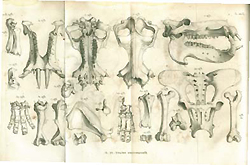Origins of the Origin
Evolution Before Darwin continued

Hippopotamus bones, in Georges Cuvier, Recherches sur les ossemens fossiles, 1821
Cuvier affirmed—and proved to his scientific contemporaries’ satisfaction—the reality that older forms had become extinct, and that new forms had been created, though he did not explain how this happened. To provide conceptual unity, he posited a limited number of structural forms that life could take—vertebrata, articulata (insects and arthropods), mollusca, and radiata (worms, sea anemones and similar creatures)—each of which expressed itself with great variety.

Table of Contents, Carolus Linnaeus, Systema naturae, 1735
Cuvier denied a science of change by positing different, complete, static systems in different epochs. But other naturalists tried to engage the question of change—most notably a contemporary, Jean-Baptiste Lamarck (1744-1829), a scholar of invertebrate zoology. Lamarck affirmed that species were not fixed but changeable, the result of a balance of forces: an inherent force of complexity matched by an internal process of adaptation, conducted at the level of anatomy and physiology, with the whole scheme relying on the inheritance of new traits and forms. The result, he claimed, was progressive improvement—yet Lamarck relied on laws that he could not demonstrate. Indeed, Darwin’s own grandfather, Erasmus Darwin (1731–1802), an English physician-poet, expressed similar ideas of progressive complexity, adaptation, and change in his epic poems, and provided no more proof. A science of change was needed, but no one could see what it would be.
Darwin and the Beagle voyage
In the 1820s and early ’30s, Charles Darwin was just entering his study of natural history. He chafed against his given courses—medicine at Edinburgh, 1825-27; preparation for ordination at Cambridge, 1828-31—and relished his unsanctioned one: natural history. At Edinburgh, Darwin discovered his love of the natural world, which he indulged through the Plinian Society, an amateur naturalist society that he joined in 1826, a year into his medical studies. An independent scholar of marine life, Robert Edmond Grant (1793-1874), led the society and inducted Darwin into the disciplines of specimen collection and description. Soon Grant presented Darwin’s own discoveries in natural history—on the life cycle of leeches—to the more elite community of Edinburgh naturalists, the Wernerian Society (named for German geologist Abraham Gottlob Werner [1749-1817], the founder of the “Neptunist” or sea-based school of geological formation).
Last Reviewed: May 7, 2014


